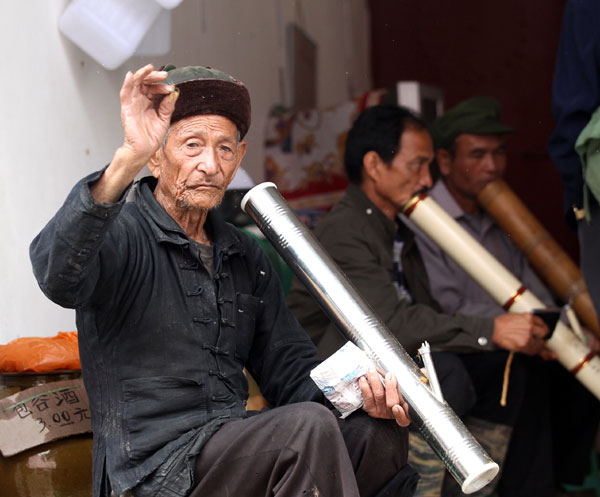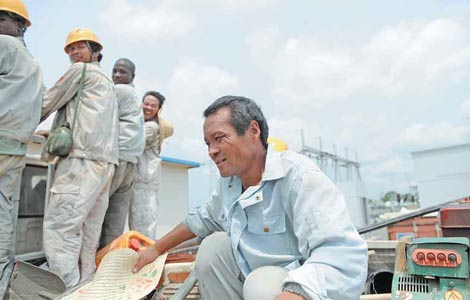Terraces on top of the world
Updated: 2013-07-26 06:35
By Hu Yongqi and Li Yingqing (China Daily)
|
|||||||||||
The Yuanyang county government was farsighted and recognized the area's potential. In late 2009, it brought in Expo Tourism Co, based in the provincial capital, Kunming, to develop tourism on the terraces. A sealed highway that linked four large villages was laid, enabling tourists to undertake a 45-km round trip that passes through 82 villages.
The Hani terraces are Yunnan's fifth World Heritage site, alongside sights such as the Old Town of Lijiang and the Stone Forest. Recognition hasn't always been a boon, though; as tourism developed and visitor numbers swelled in Lijiang, many of the native Naxi people fled the city, which had become unpleasantly overcrowded in peak season.
 |
|
Hani men enjoy their leisure time in Yuanyang. [Photo by Zhang Wei/China Daily] |
In 2007, the Stone Forest in Kunming was declared a World Heritage site and three years later the number of visitors to the attraction in the Karst landscape had tripled. Although the extra income was welcome, the large number of visitors threatened to damage the environment and swamp the local culture.
That experience has set experts thinking about the best way to avoid a similar problem at the Hani terraces.
The terrace in Yuanyang, a core area of traditional farming techniques in Honghe, is expected to welcome 1.5 million visitors this year, an increase of 60 percent year-on-year, said Lu Jianguo, director of the county's tourism bureau. "At present, there are no plans for any further construction work in the terrace area. The most important thing is to keep the terrace intact," he said.
Honghe's 1.26 million Hani population accounts for more than half of all the people living in this ecosystem of forests, villages, rice terraces and rivers. The water flowing through the forest forms streams and small rivers that provide drinking water for the villagers and irrigate the rice terraces.
In every village, a stone monument has been erected at the "water entrance" to the fields and on Hani New Year's Day, which falls in late October or early November, the locals worship the water god and pray for a good harvest.
Expo Tourism spent more than 120 million yuan on the construction of the scenic sites that surround the terrace areas. However, the number of buildings contravened UNESCO regulations and so several were demolished, resulting in a loss of 13 million yuan for the company.
Li Shufa, deputy general manager of Expo Tourism, said no new permanent buildings will be erected on the site and the local government is attempting to strike a balance between the development of tourism and local culture.
"I don't want my people to become 'performers'. The Hani people were born to continue the history of the terraces," said Zhang Hongzhen, director of the Honghe Hani Terraces Protection Bureau.
Lyu Yasha, director of the Honghe tourist bureau, echoed Zhang's comment, saying the terraces showcase respect for nature and indicate the Hanis' reluctance to abandon their land and traditional farming techniques.
She believes that the Hani and other ethnic groups that cultivated Honghe's terraces were at the center of the area's development. "It's a quick and efficient way of raising the locals' standard of living. They should also enjoy the fruits of tourism," she said.
Related Stories
Leave a moment of peace for the Hani Terrace 2013-07-15 11:06
Hani terrace:a new World Heritage sitexia 2013-06-28 11:38
Stunning photos of Hani terrace 2013-06-26 16:13
Stunning photos of Hani terrace 2013-06-26 16:13
Hani terraces named UNESCO world heritage 2013-06-26 15:20
Hani terrace:a new World Heritage sitexia 2013-06-24 13:03
Today's Top News
Indictment shows CPC's stance on corruption
Japanese PM unlikely to visit Yasukuni Shrine
Top DPRK leader meets Chinese vice-president
FDI to maintain growth in H2
EU 'students' get access to Chinese culture
Girl, 2, thrown to ground; suspect detained
New industries lead job growth
Crackdown a bitter drug to herald changes
Hot Topics
Lunar probe , China growth forecasts, Emission rules get tougher, China seen through 'colored lens', International board,
Editor's Picks

|

|

|

|

|

|





